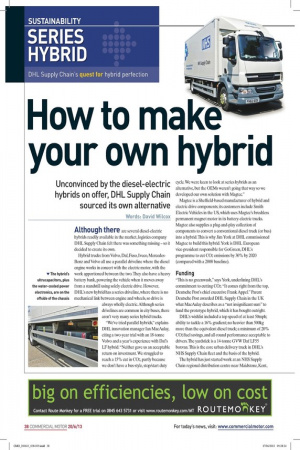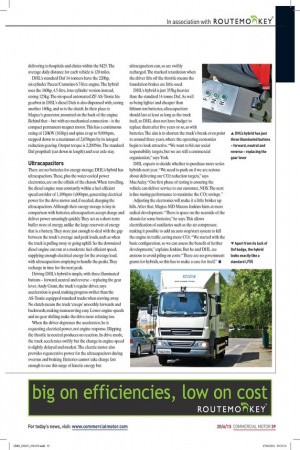How to make your own hybrid Unconvinced by the diesel-electric
Page 31

Page 32

If you've noticed an error in this article please click here to report it so we can fix it.
hybrids on offer, DHL Supply Chain sourced its own alternative Words: David Wilcox Although there are several diesel-electric hybrids readily available in the market, logistics company DIAL Supply Chain felt there was something missing — so it decided to create its own.
Hybrid trucks from Volvo, Daf, Fuso, Iveco, MercedesBenz and Volvo all use a parallel driveline where the diesel engine works in concert with the electric motor, with the work apportioned between the two. They also have a heavy battery bank, powering the vehicle when it moves away from a standstill using solely electric drive. However, DIAL's new hybrid has a series driveline, where there is no mechanical link between engine and wheels, so drive is always wholly electric. Although series drivelines are common in city buses, there aren't very many series hybrid trucks.
"We've tried parallel hybrids," explains DHL innovation manager Ian MacAulay, citing a two-year trial with an 18-tonne Volvo and a year's experience with Dal's LF hybrid. "Neither gave us an acceptable return on investment. We struggled to reach a 15% cut in CO2, partly because we don't have a bus-style, stop/start duty cycle. We were keen to look at series hybrids as an alternative, but the OEMs weren't going that way so we developed our own solution with Magtec."
Magtec is a Sheffield-based manufacturer of hybrid and electric drive components; its customers include Smith Electric Vehicles in the US, which uses Magtec's brushless permanent magnet motor in its battery-electric trucks. Magtec also supplies a plug-and-play collection of components to convert a conventional diesel truck (or bus) into a hybrid. This is why Jim York at DIAL commissioned Magtec to build this hybrid. York is DIAL European vice-president responsible for GoGreen, DIAL's programme to cut CO2 emissions by 30% by 2020 (compared with a 2008 baseline).
Funding "This is no greenwash," says York, underlining DIAL's commitment to cutting CO2. "It comes right from the top, Deutsche Post's chief executive Frank Appel." Parent Deutsche Post awarded DIAL Supply Chain in the UK what MacAulay describes as a "not insignificant sum" to fund the prototype hybrid, which it has bought outright.
DIAL's wishlist included a top speed of at least 50mph; ability to tackle a 16% gradient; no heavier than 500kg more than the equivalent diesel truck; a minimum of 20% CO2/fuel savings, and all-round performance acceptable to drivers. The yardstick is a 14-tonne GVVV Daf LF55 boxvan. This is the core urban delivery truck in DIAL's NHS Supply Chain fleet and the basis of the hybrid.
The hybrid has just started work at an NHS Supply Chain regional distribution centre near Maidstone, Kent, delivering to hospitals and clinics within the M25. The average daily distance for each vehicle is 120 miles.
DITL's standard Daf 14-tonners have the 220hp, six-cylinder Paccar/Cummins 6 7-litre engine. The hybrid uses the 160hp, 4.5-litre, four-cylinder version instead, saving 125kg. The six-speed automated ZF AS-Tronic lite gearbox in DITL's diesel Dafs is also dispensed with, saving another 140kg, and so is the clutch. In their place is Magtec's generator, mounted on the back of the engine Behind that but with no mechanical connection is the compact permanent-magnet motor. This has a continuous rating of 120kW (161hp) and spins at up to 9,000rpm, stepped down to a maximum of 2,650rpm by its integral reduction gearing. Output torque is 2,200Nm. The standard Daf propshaft (cut down in length) and rear axle stay.
Ultracapacitors There are no batteries for energy storage; DITL's hybrid has ultracapacitors. These, plus the water-cooled power electronics, are on the offside of the chassis. When travelling, the diesel engine runs constantly within a fuel-efficient speed corridor of 1,10Orpm-1,600rpm, generating electrical power for the drive motor and, if needed, charging the ultracapacitors. Although their energy storage is tiny in comparison with batteries, ultracapacitors accept charge and deliver power amazingly quickly. They act as a short-term buffer store of energy, unlike the large reservoir of energy that is a battery. They store just enough to deal with the gap between the truck's average and peak loads, such as when the truck is pulling away or going uphill. So the downsized diesel engine can run at a moderate fuel-efficient speed, supplying enough electrical energy for the average load, with ultracapacitors emptying to handle the peaks. They recharge in time for the next peak.
Driving DIAL's hybrid is simple, with three illuminated buttons forward, neutral and reverse replacing the gear lever. Andy Grant, the truck's regular driver, says acceleration is good, making progress swifter than the AS-Tronic-equipped standard trucks when moving away. No clutch means the truck 'creeps' smoothly forwards and backwards, making manoeuvring easy. Lower engine speeds and no gear shifting make the drive more relaxing too.
When the driver depresses the accelerator, he is requesting electrical power, not engine response. Blipping the throttle in neutral produces no reaction. In drive mode, the truck accelerates swiftly but the change in engine-speed is slightly delayed and modest. The electric motor also provides regenerative power for the ultracapacitors during overrun and braking. Batteries cannot take charge fast enough to use this surge of kinetic energy but ultracapacitors can, so are swiftly recharged. The marked retardation when the driver lifts off the throttle means the foundation brakes are little-used.
DIAL expects to decide whether to purchase more series hybrids next year. "We need to push on if we are serious about delivering our CO2 reduction targets," says MacAulay. "Our first phase of testing is ensuring the vehicle can deliver service to our customer, NHS. The next is fine-tuning performance to maximise the CO2 savings.
Adjusting the electronics will make it a little brisker up hills After that, Magtec MD Marcus Jenkins hints at more radical development. "There is space on the nearside of the chassis for some batteries," he says. This allows electrification of auxiliaries such as the air compressor, making it possible to add an auto stop/start system to kill the engine in traffic, saving more CO2. "We started with the basic configuration, so we can assess the benefit of further developments," explains Jenkins But he and DIAL are anxious to avoid piling on costs: "There are no government grants for hybrids, so this has to make a case for itself." •









































